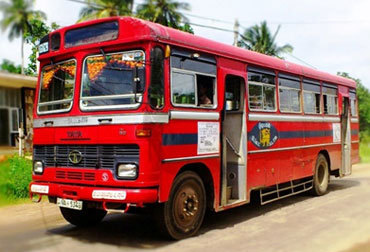Towards a better bus service
 The Government’s plan to import and deploy an additional 2,000 buses
for the Sri Lanka Transport Board is commendable. A sum of Rs.1,000
million has been allocated for this endeavour. The SLTB’s fleet is
nowhere near that of the private sector, which seemingly has a
commanding lead in the passenger transport sector. This will help
augment the SLTB fleet to some extent. The Government’s plan to import and deploy an additional 2,000 buses
for the Sri Lanka Transport Board is commendable. A sum of Rs.1,000
million has been allocated for this endeavour. The SLTB’s fleet is
nowhere near that of the private sector, which seemingly has a
commanding lead in the passenger transport sector. This will help
augment the SLTB fleet to some extent.
While most urban areas are well served by the private bus network, in
rural areas the SLTB has become a lifeline for commuters who have to
wait an hour or more to catch a bus. Since most of the rural roads are
uneconomical, most private bus operators (whose sole motive is profit,
not passenger welfare) do not deploy buses on these roads.
The SLTB does not have enough buses to cater to all rural roads and
this step will help SLTB authorities to deploy additional buses.
However, the SLTB should identify priority routes and allocate buses
accordingly.
It is also prudent to import more small to mid-size buses, given that
most rural routes would not be very profitable. They are also more
easily manoeuvrable especially in mountainous terrain with hairpin
bends. There will be no capacity for the bigger buses in many rural
areas. These buses also require more fuel and the resultant fuel savings
from smaller buses would be significant. However, bigger buses (with
more seating and standing capacity) can be deployed on urban routes
which are in high demand.
Replacement
There are also hundreds of buses lying idle at SLTB depots
island-wide for want of simple repairs, such as tyre replacement. These
can be repaired easily and re-deployed for the benefit of passengers. If
a particular depot finds that it has more buses than it can handle after
the repairs are completed, such buses can be given to a deserving depot
in a rural area.
 Given a choice, most people still like to travel by SLTB buses since
the bus crews are courteous, disciplined and professional. In this
regard, the additional buses will help the SLTB to compete more
effectively with the private operators, even though there is still no
level playing field. Given a choice, most people still like to travel by SLTB buses since
the bus crews are courteous, disciplined and professional. In this
regard, the additional buses will help the SLTB to compete more
effectively with the private operators, even though there is still no
level playing field.
The transport authorities have now formulated a joint SLTB - private
bus timetable for most provinces, which will also help reduce the gap
and afford a more convenient service to commuters. Since there had been
several earlier attempts to implement such timetables, we hope it is
implemented correctly this time. If implemented properly, both parties
(SLTB, private buses) and passengers will benefit.
Another recent story that caught my attention was that all SLTB
depots have been asked to comply with the directive to display
destination boards in all three languages. There still are instances
where destination boards are not displayed in Sinhala, Tamil and
English.
Most private buses have now switched to LED boards to display the
destination in all three languages. The cost of these boards has
plummeted drastically over the last few years and it will be a
worthwhile investment for the SLTB too. The bright boards can be seen
clearly even in pitch darkness and those with vision problems will also
benefit. The boards can easily be re-programed to display a new
destination in all three languages if the bus is deployed to another
route/destination.
Expressway
These boards have already been installed on the SLTB’s fleet of
luxury buses used on expressway routes and certain other urban routes
such as Colombo - Panadura. There has been a tremendous response to the
SLTB luxury bus service for which passengers pay several times the
normal fare. The SLTB must identify more routes on which such services
could be introduced successfully.
There were several previous attempts to persuade those who come by
car to Colombo to keep their cars at home and come to work by luxury
bus.
The authorities must probe why they failed and take appropriate
action to rectify any shortcomings in the future. This is a scheme that
can potentially reduce the large number of cars that enter Colombo daily
and save a considerable amount of fuel collectively.
There should also be closer coordination between bus and train
authorities. Just like transit connections at an airport, a train
station can be a ‘feeder hub’ for an entire area.
If bus and train timetables can be more closely aligned, commuters
will benefit through a combination of ideal transport solutions. This is
already being done in certain areas, but it should be formalised.
A good bus service and other public transport services are essential
for a developing economy. We should look at how other countries,
especially those with similar demographics, have developed their bus
services and take a cue to develop the local bus service, rural and
urban.
|

